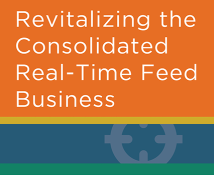In the age of algorithmic trading with execution speeds measured in microseconds, the race to reduce market data latency has captured the attention of market data professionals and quantitative traders for the better part of a decade.
Media attention on principal trading firms (aka HFT), coupled with recent books and movies like Flash Boys, has only intensified the spotlight. This focus on direct exchange feeds, coiled-up fiber, microwave delivery, and fortress-like data centers has ignored what is still one of the most widely used market-data products across the capital markets—real-time consolidated feeds.
It is a common misunderstanding that consolidated feeds are great for screen-based consumption, but from an algorithmic execution perspective, direct feeds are the only way to go. While this may be true for the small subset of the market that profits only from being the fastest, investment in data-feed consolidation over the last 10 years has improved performance dramatically.
In fact, the quality of these third-party offerings is often seen as the major argument for replacing the exchange-run securities information processor (SIP)—a feed often derided for its high latency and occasional outages.
MethodologyDuring Q1 2016, Greenwich Associates interviewed providers and consumers of consolidated data feeds about the evolving market, changing costs and the competitive landscape, and analyzed data inputs from Alphacution, Burton Taylor and other public sources.

